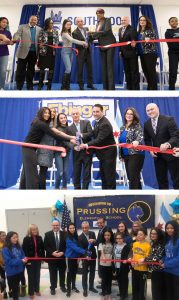2/27/2019

Mayor Rahm Emanuel, Chicago Public Schools and local officials today opened a new school building at South Loop Elementary School, and annexes at Prussing and Ebinger Elementary Schools. With capacity for an additional 1,080 students at South Loop, 150 at Prussing and 180 at Ebinger, more than 1,400 new seats will be added across the three schools.
“An investment in a school facility not only expands opportunities for students, it helps lay the foundation to build on the remarkable academic gains they are making,” said Mayor Emanuel. “From the northwest to the southeast side of the city, we are thrilled to provide our students with the state-of-the-art facilities and extra space necessary to prepare them for a successful future.”
“Students deserve a learning environment that sparks curiosity and helps them develop academically,” said CPS CEO Dr. Janice K. Jackson. “We are excited to open new state-of-the-art facilities across the city that will contribute to the fabric of the community and provide our students with rich opportunities to learn and succeed.”
The new South Loop Elementary School building is a 120,000 square foot, four-story facility with 32 typical classrooms, including: computer labs, science labs, art rooms, a gymnasium with stage, a student services center, a multipurpose room, and a rooftop play area. The site also includes a playlot, parking lot and landscaping.
“The new South Loop Elementary School is a sound investment in current and future students, and in our growing community,” said Alderman Pat Dowell, 3rd Ward. “Our students are achieving record academic gains and I look forward to seeing this growth continue in the new building.”
The new building will accommodate Grades 4-8, and the existing facility will accommodate Grades K-3. South Loop Elementary School now has the capacity to serve approximately 1770 students.
The new annex at Ebinger Elementary School is a 32,000 square foot, two-story facility with 7 standard and 3 special needs classrooms. The annex houses a science room, computer room, art room, and a multipurpose room with a kitchen and lunchroom.
“The new annex brings to life a community vision for the future of our Ebinger students, who are achieving record academic success,” said Alderman Anthony Napolitano, 41st Ward. “This important investment will help set the foundation for our students to thrive for generations to come.”
The existing modular classrooms were removed, and a new parking lot, playground and landscaping were added to the site. The kitchen and lunchroom in the original building were converted into two classrooms.
The new annex at Prussing Elementary School is a 23,000 square foot, single-story facility with two general classrooms, a computer lab, science room, art room, music room and a kitchen and dining area. The existing modular buildings were removed, and a new parking lot, turf field and landscaping and paving were added to the site.
“The Prussing annex brings the extra space and modern facilities necessary for students and students to focus on their education,” said Alderman John Arena, 45th Ward. “Prussing students now have a space that matches the first-rate education they are earning.”
Improvements to the existing Prussing building included: the conversion of the kitchen and lunchroom into kindergarten classrooms, a roof replacement and structural and masonry repairs.
The projects were constructed by the Public Building Commission.
Mayor Emanuel and CPS have addressed overcrowding at over 40 local schools in recent years, including Zapata, Dore, Dawes, South Loop, Prussing, Addams, Little Village, Bridge, Onahan, Ebinger, Pasteur, Canty, Byrne, Edwards, Garvy, Hale, Peck, Stevenson, Dirksen, Sauganash, and many more. The Mayor remains committed to working with communities to find innovative ways to relieve overcrowding.
Under Mayor Emanuel’s leadership, more than $3.2 billion has been invested in school infrastructure. Investments with CPS has included new schools and annexes, playgrounds and air conditioning, improvements and access to technology, new computers and expanded bandwidth, expanded academic programs and core facilities investments.


